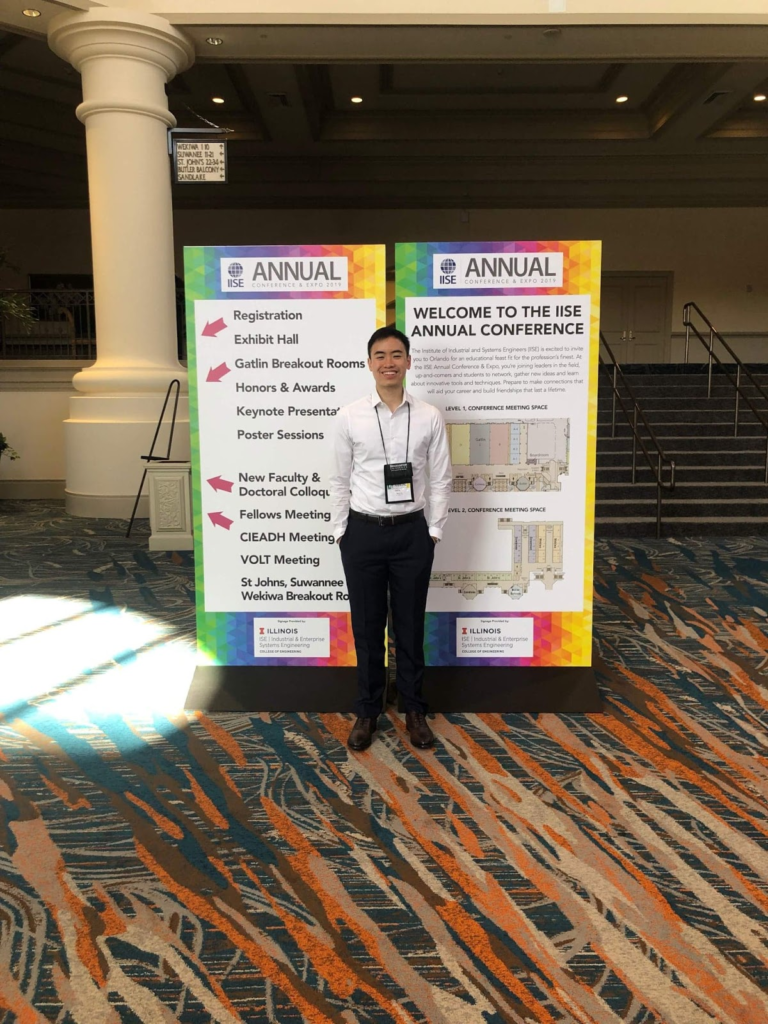Berkeley Students Take on the National Institute of Industrial and Systems Engineers (IISE) Conference
By Kelly Han and Nicholas Foo | September 16, 2019
A crucial component of academic and professional development is the exploration of knowledge and possibility. It can be learned in many ways through classes, mentorships, internships, peers, etc., but there was one place that combined all of these and on a national platform. This is what the IISE (Institute of Industrial and Systems Engineering) Annual Conference & Expo held in Orlando, Florida provided for two undergraduate IEOR students looking to explore current relevant research in industrial engineering and meet other sister chapters.

IEOR undergraduate Kelly Han posing with the Berkeley IEOR flag at the IISE Annual Conference & Expo 
IEOR undergraduate Nick Foo
The layout of the conference involved three keynote speakers, workshops/presentations/research seminars throughout the day, and a career fair. The keynote speakers, for us, were the highlight of the conference; not only were they incredibly impressive in their careers but also varied in their pathways through industrial engineering.
The first speaker was Lieutenant General Stayce Harris who spoke about her upbringing and how a scholarship to industrial engineering was a stepping stone to becoming the first African American female to become a Lieutenant General in the U.S. Air Force. She credits industrial engineering with giving her the logical and analytical mindset of an engineer to think through situations and problems in a methodical manner.
The second speaker, Dr. Pascal Van Hentenryck, professor at Georgia Tech, spoke about the importance of mobility and accessibility. He wanted to address these issues for two main reasons, one because they have an increasing impact on society, and two, because they are raising scientific and technological challenges that the industrial engineering community are primed to solve. He talked specifically about transit models, and how density, culture, existing infrastructure, budget, geography, demographics, and so many other factors need to be taken into account to create the most efficient transportation model. He highlighted the Six Principles of Sharing Systems (spatial proximity of riders, temporal proximity of riders, guaranteed ride back home, low coordination costs, low trust concerns, clear commuter roles), the psychology of riders, and the politics that come into play that can often hinder or spell out the success of a successful public transportation system.
The final speaker was Sylvia Acevedo, CEO of Girl Scouts of America. She credited industrial engineering as “the perfect blend of analytical skills, organization, and business.” She talked about her journey of growing up and loving math, her work at NASA Jet Propulsion Laboratory, and her service as Director of Latin America at Autodesk. She talked specifically about the critical question she addressed, which was “how to scale,” for in Latin America, she had to increase the revenue of Autodesk sales. However, a large problem was that there were many pirated copies of Autodesk software, which she learned on the taxi ride from the airport to her hotel as her taxi driver offered her a free copy from his glove compartment. She shared about the impact she has made as CEO of Girl Scouts of America (creating new badges that revolve around tech, cybersecurity, rocket science, mechanical engineering, etc.) and her experiences as a Latina woman engineer. Hearing about her many accomplishments and listening to her story were powerful, but it was her presence that stood out. She is one of the rare individuals who, from simply the way she graced the podium, radiated strength, resilience, and ambition. To us, she was a pillar of inspiration.
The smaller side workshops and seminars were equally eye-opening. Companies such as United, UPS, Lockheed, and Disney talked about the operations that industrial engineers are in charge of within their workplaces. Graduate students and professors shared their research with topics ranging from creating Unmanned Aerial Vehicle (UAV) logistic models for coastal and offshore locations, to creating the ideal grocery store layout, to minimizing hospital operating room costs.
Another highlight of the conference included meeting up with the San Jose State IISE chapter. They were excited to expand and provide more opportunities for their members, and we exchanged a string of ideas of how we want to organize our respective IISE departments. We’re also looking forward to future collaborations with them for this upcoming school year.
Walking away from this conference, we leave with a greater understanding, but also excitement for IEOR. Having role models that we can look up to academically and professionally and being able to set a sight of where we want to potentially be in industry is empowering and motivating. We feel blessed that we were able to experience this, and we thank the IEOR department for giving us this opportunity. We are excited to come back to Berkeley with a greater understanding of the breadth and depth of problems that industrial engineers can pursue and more ideas to share and explore within our own IISE student branch and beyond.